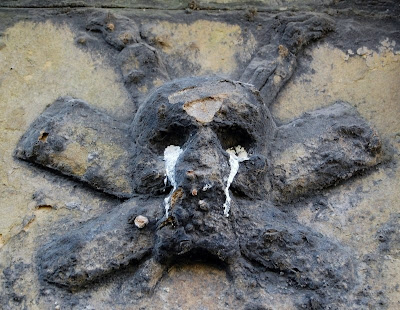Haunted Edinburgh: Greyfriars Kirkyard
Edinburgh. December, 1998:
He was soaked through four layers, his body aching from an epicentre in his belly. At any moment it felt as if all of his insides would abandon post and blow up, crash through his bones and skin and splatter into the cold air. Anything to spread a little warmth.
It is easy to stay to the shadows in a graveyard. Greyfriars must breed half of Edinburgh’s winter gloom, a parade of silhouettes slithering out from the womb of stone and moonless sky.
All the same he kept to the sides, trying the gates of each tomb as he went. Finally, one tomb so black it could have blended into the night. But the gate had not been locked, and inside the cold seemed at least to be holding still. It would do.
With palms flat against the stone and eyes wide open like funnels sucking in the darkness, he made his way towards the back of the tomb, to find a quiet corner and wait out the storm.
Clunk. His foot moved from the earth to what felt and sounded like wood. Impulse made him lift his left boot and bring it down three times, like a knock on a door.
Knock knock kno…
And he was gone, his mouth opening in a silent cry as he fell through the rotten floor, taking damp earth and stones with him. A moment of chaos and clamber, then nothing. He retched himself up to sitting and breathed into the ballooning silence.
He had fallen onto uneven ground, which poked into him and made it difficult to find his balance. His hands slipped around, trying to make sense of it all.
Even in the dark, there are bones the shape of which are so familiar that we can build the picture in our minds of their place on the skeleton. Now he was surrounded by them, his fingers moving over skulls, over the linking charms of finger joints and the batons of fibula. His imagination doused the scene in the green slime he knew was there, because he could feel it clinging to him.
He screamed as he reached up and through the jagged hole where he had broken through, his dirty hands emerging into the gloom like a shock scene in a horror film. Two hard pulls brought him back to the surface, and as soon as he found his feet he began to run. He hurled straight through the graveyard this time, towards the nearest lamp which illuminated the falling rain. A light to erase the shadows, the rain promising to wash everything away.
Did you like that? Since that fateful night, Greyfriars Kirkyard has never been the same. Because you see, it seems that someone, or something, was unleashed when the man fell through. The unfortunate man claimed it was the evil ghostly energy of none other than Mackenzie himself.
The reports began almost immediately. People visiting the area told of how they were attacked by something they could not see. Often their hair was pulled, or they suddenly lost consciousness, despite having no history of such occurrences.
Scratches and bruises appeared on their arms and legs the day after visiting the site. An exorcist even had a go at ridding the place of what had become known as Mackenzie’s Poltergeist. The exorcist said it was not possible - the energy was too strong, and he feared for his life. A few weeks later he died of a heart attack.
In this age of concern for public safety, Edinburgh Council thought it best to close off the area entirely, until a ghost tour company convinced the council to let them lead small groups of people into the tomb while telling visitors the history of the area. (Mackenzie’s tomb is on the left down past the locked gate. There is no way in now without an official guide).
Now I’ve been on the City of the Dead tour, and it was, as JP would say, wank. They stuffed a dozen of us into the black mausoleum and made us wait there in the dark to see if anything would happen.
We all stood in silence, some of us hoping, willing this demonic ball of energy to graze our necks with icy licks. Nothing. Well, until one of the tour guides jumped out like a bogeyman in an attempt to illicit some screams. Talk about ruining the vibe.
Never mind. The story -and all the unanswerable questions - are what matter. For example, why Mackenzie? Was it because during his years as a lawyer he so mercilessly persecuted the Covenanters, who chose Presbyterianism over the crown’s favoured Episcopacy?
His relentless cruelty toward them is why he became known as “Bluidy” Mackenzie. How high and mighty of him - sending down all those poor folks for their beliefs. How very awkward for him then to eventually be buried in the same ground as many of those who died as a result of his prosecution. Perhaps that is the cursed friction that keeps him spinning out of the grave.
Greyfriars Kirk is my most beloved graveyard, simply because it is so creepy. I love the dancing skeletons and the giant tombs. I love the gravestones that look to be slowly sinking into the mud.
I should add that the reason there were so many bones under the floor was the churchyard was apparently the home to many unregistered burials during the plague. The number of headstones in the graveyard is estimated to be just a fraction of the number of bodies underfoot.
If you fancy reading more about the ghouls and ghosts of Scotland’s capital, pop over to Edinburgh’s Dark Side.
I’ll haunt you later…(oooooh...chocolate eyeballs!)





























































